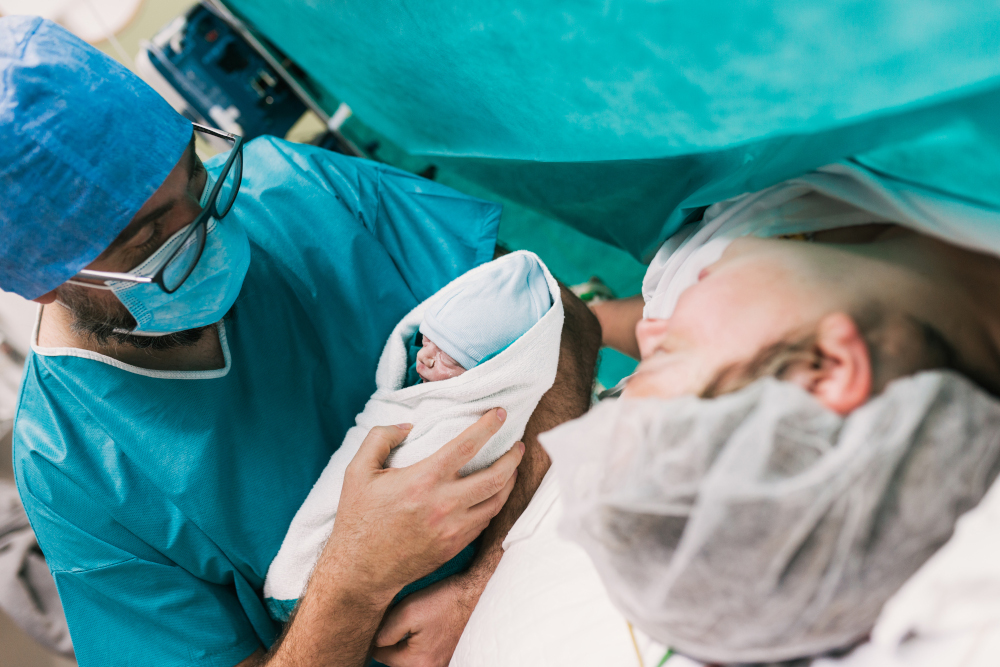Caesarean section rates are rising, and that impacts breastfeeding rates, too.
As of 2020, around 32% of all births in the U.S. were caesarean sections. In situations like prolonged or obstructed labor, fetal distress, or breech presentation, a C-section can be a life-saving procedure, significantly reducing risks to mother and child. However, C-sections come with their own risks, including infection, slower recovery times, and delays in establishing skin-to-skin contact. All of these risks can impact a mother’s ability to initiate and maintain breastfeeding.
How does a Caesarean delivery impact breastfeeding?
Skin-to-skin contact post-delivery is important for moms who wish to breastfeed. This early bonding opportunity awakens an infant’s nursing reflexes, which is key to establishing an effective breastfeeding latch. Studies show that babies who had early skin-to-skin contact were “more likely to exclusively breastfeed at hospital discharge, to be exclusively breastfed after discharge, and to breastfeed for longer durations.”
The longer recovery time required post-caesarean disrupts this critical window for breastfeeding initiation, milk supply, and infant breastfeeding reflexes. Researchers suggest this may explain the higher rate of breastfeeding cessation among mothers who delivered via C-section.
Breastfeeding post-caesarean may be more challenging, but it’s not impossible.
Just because you’re having a C-section, doesn’t mean breastfeeding is impossible. In fact, most hospitals work hard to protect the golden hour, even for mothers who had a touch-and-go delivery. Even if you miss the golden hour, making time for skin-to-skin contact as soon as possible after delivery can help to overcome issues. Not only is it possible for moms to breastfeed after a delivery, experts recommend it as a way of countering the other health risks associated with C-sections, such as infant respiratory distress and infection.
Let your doctor know your wishes related to breastfeeding.
Talk to your doctor as early as possible about your desire to breastfeed. They will be able to provide the best possible guidance on how to initiate breastfeeding in the event of an emergency or planned C-section. By making your wish known early, your team can begin to plan for successful breastfeeding, especially by actively protecting early skin-to-skin contact as much as possible.
Use a breast pump to stimulate milk production.
Women who have a C-section often experience a delay in milk production due to the lapse in time between delivery and first breastfeeding attempt. If you and your baby have to be separated after your C-section for additional care, have your breast pump on hand to stimulate your breasts to begin producing milk. Pump every two to three hours until you are able to be reunited with your newborn.
Access hospital resources to improve your odds of breastfeeding success.
If you’ve had a C-section, your body will be more vulnerable, and you may be hooked up to an IV line, blood pressure cuff, and monitor. This can make attempting to breastfeed even more daunting. However, you’ll also be in the hospital longer, which gives you more time to connect with nurses and lactation specialists who can provide guidance and support for more comfortable, effective breastfeeding.
Spend as much time skin-to-skin with your baby as possible.
Even if you’re unable to breastfeed straight away, just spending time skin-to-skin with your little one will help to stimulate a bond and breastfeeding instincts in your baby. Be sure to have your partner or a friend or family member in the room with you to help should you need to move or put baby down for a while.
Breastfeeding will get easier as you recover from your surgery.
If you’re having a C-section and you plan to breastfeed, it’s a good idea to prepare for challenges early. Talk to your doctor about your wishes as early as possible. Find a breast pump that you feel comfortable with before your delivery. And, of course, take advantage of every resource available to you. At Milk N Mamas Baby, we have more than two decades of experience in the medical device supply industry, with specialization in breast pumps, pumping essentials, and breast pumping accessories. The women on our team are dedicated advocates for mamas and babies every day, and we’re happy to be your reliable resource in pumping and breastfeeding.
